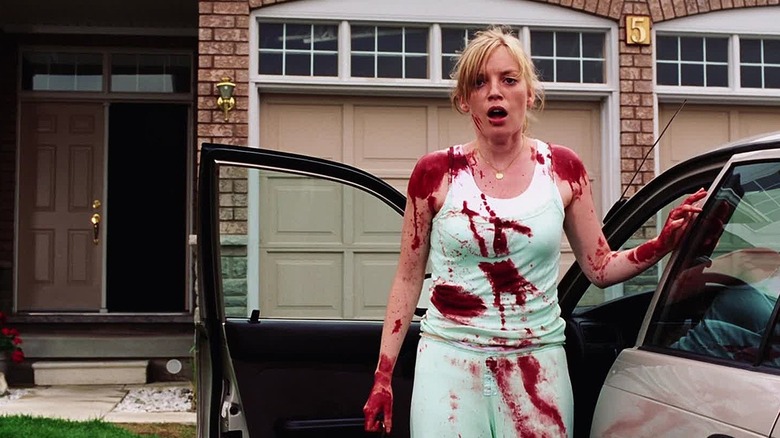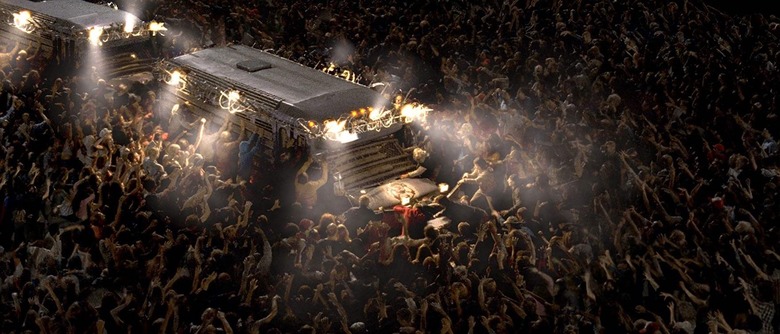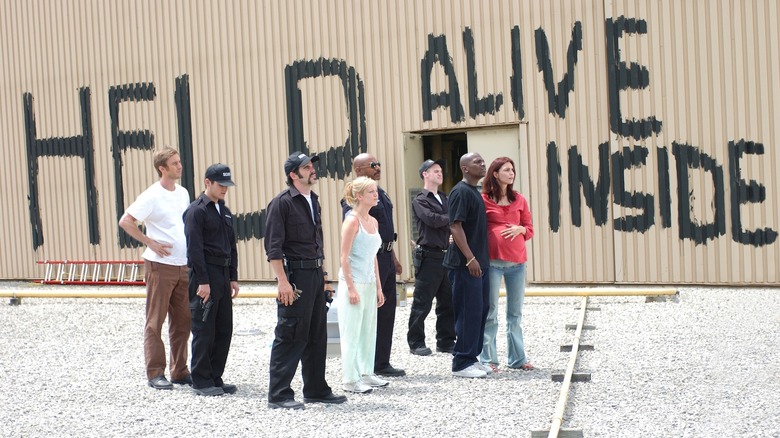'Dawn Of The Dead' At 15: Zack Snyder's Best Film Is The One With Zombies, Not Superheroes
As it pertains to comic book movies, the name Zack Snyder can be a rather contentious one. Snyder's filmography reads like a wish list of Hollywood adaptations that a reader of Wizard: The Guide to Comics could have only meekly fantasized about back in the 1990s. 300, Watchmen, Man of Steel, Batman v Superman, Justice League. If you fired up Doctor Doom's time platform and traveled to a convention floor in the past, carrying an envelope with only those five titles credited to the same director, fans would think you had come bearing tidings of a John-Connor-like movie messiah for comic book nerds.
Whatever you make of the actual end products that resulted from Snyder's efforts, the fact that he or anyone was able to marshal big-budget attempts at bringing such properties to life is surely a dream come true by '90s geek standards. Before his cinematic M.O. ever became linked to the all-important subject of comic book movies, however, Snyder was a director with a background in music videos who would cross over into feature filmmaking with a remake of George Romero's 1978 zombie film Dawn of the Dead.
Snyder's version of Dawn of the Dead hit theaters on March 19, 2004. In this movie, the characters aren't superheroes or Spartan warriors with washboard abs. They're everyday people thrust together in an extraordinary situation. That dose of humanity at once makes Dawn of the Dead more down-to-earth and relatable than any CGI-laden superhero slugfest. With a screenplay by James Gunn, who would also go on to become a key figure in the comic book movie genre with Guardians of the Galaxy, this is Snyder's most street-level film. It's also his best.
A Cold Open for the Ages
Dawn of the Dead was one of the first big American zombie movies out of the gate after 28 Days Later. As I wrote last year in a 15th-anniversary article about that film, zombies were in the ether in a major way back in 2002 through 2004. Snyder's film adheres to the same fast zombies trend but that's not the only page it takes out of the Danny Boyle playbook. Like 28 Days Later (and later, The Walking Dead on television), Dawn of the Dead starts out in a hospital. Rather than being abandoned and spooky, however, this hospital is still buzzing with life, because when the movie begins, we're pre-apocalypse.
As a genre artifact, Dawn of the Dead is perhaps best remembered for its bravura cold open. It's eleven and a half minutes before the film's title appears on-screen and its opening credits begin. In that time, Snyder manages to draw us into the life of one character and then open the world out around her to where it encompasses a citywide end-of-the-world nightmare.
Sarah Polley's character, Ana, isn't an Amazonian demigoddess with a lasso of truth. She's a nurse at the end of a long shift who just wants to get home so she can have date night with her husband. As the movie fades in, we see her standing in the hallway next to a doctor who's on the phone with his golf buddy, talking about "teeing off" in the morning.
Little do they know that the world is about to go to shit. Needless to say, that doctor probably won't be making his tee time.
In their suburban Milwaukee home, Ana and her husband wake up the next morning to find a zombified neighborhood girl in their house. The girl attacks and kills Ana's husband, taking a big bite out of his neck and leaving him to reanimate on the bed as one of the undead.
James Gunn is a Stephen King fan and he's listed both 28 Days Later and Stanley Kubrick's The Shining among his fifty favorite horror movies of all time. It could be a coincidence, but there are a few moments in Dawn of the Dead that play like little homages to The Shining (both the Kubrick film and the more faithful 1997 TV mini-series adaptation, which had its moments despite its lesser reputation).
Retreating into the bathroom to escape her undead husband, Ana takes a messy spill backward into the bathtub. When she gets up, her foot lands on the rug in a shot framed similar to the one in The Shining TV mini-series where we first see the green rotting foot of the woman in room 217 step out of the tub. Ana's husband also butts his head through the door like a zombified Jack Torrance, one who gives animalistic snarls instead of quipping, "Here's Johnny!" Elsewhere in the movie, per King's original idea of Torrance, we see another character palm a croquet mallet as a weapon in a sporting goods store in the mall.
At other times, Dawn of the Dead feels as though it bears a heavy influence from video games, with Ana's subsequent car getaway taking on an aerial Grand Theft Auto perspective. In later Snyder films, that video game quality would become overbearing, with scenes looking green-screened to the point where they were almost wholly unreal. Dawn of the Dead, on the other hand, keeps us grounded in some semblance of recognizable reality. Instead of trench-coated bat-men in the desert with winged parademons, we see a woman in her pajamas trying to survive against the familiar backdrop of suburbia.
Outside the house in her driveway, Ana encounters a neighbor in a bathrobe, wandering around dazed in the middle of the street. He points a handgun at her right before a runaway ambulance hits him.
Perhaps the grandest shot of the whole film is the one where the camera pans across Ana's neighborhood to show how it is now a full-on riot scene with smoke and helicopters in the distance. Her husband chases her car down the street like a rabid dog until another random neighbor catches his eye and he breaks off to go eat that person.
Keep in mind that we began the movie with Ana's nursing and home life as our humble entry point. She's an unpretentious audience surrogate who anchors the noise as the chaos of burning cars, colliding vehicles, and exploding gas stations descends on Milwaukee. In the span of a few minutes, we go from being on the ground with her to seeing a bird's-eye view of her car fleeing down a long road in the city. The movie starts small, then goes big.
No Heroes, Just Humans (and Zombies)
Dawn of the Dead clocks in at a lean and mean 100 minutes. That's not something you could say for many of Snyder's superhero epics, most of which could stand to have some of the fat trimmed from their extended running times.
Movies like Watchmen and Man of Steel have taken their time exploring the human foibles behind superheroes, so it's not as though they're entirely bereft of humanity. Yet one way that the heroes of DC Comics — particularly the big guns who make up the members of Justice League — have traditionally contrasted themselves with those of Marvel Comics is that they are more mythic and godlike. Characters like Wonder Woman, Aquaman, and the Flash do correspond somewhat with Greek gods like Artemis, Poseidon, and Hermes.
In Dawn of the Dead, it's the situation, not the characters, who are larger-than-life. We see this in the ways said characters seek to cope with the situation, all the while navigating their own human weaknesses. The movie begins with a flaming skull transitioning into an X-ray, as if to show that what's really on fire in this apocalypse is the human brain.
Ving Rhames' character, Kenneth — a police sergeant with a U.S. Marine Corps tattoo — initially leans into guarded self-interest. At first, he only cares about going to meet his brother at a nearby fort, even if it means ditching these other pesky survivors, leaving them to fend for themselves in the mall. Eventually, however, we see him embrace the group he's with and forge a rooftop connection with the doomed gun store owner, Andy, by way of a whiteboard.
Michael Kelly, who played Doug Stamper on House of Cards, is less recognizable with a mustache and mall security guard hat, but his character, C.J., tries to stake out a slice of the situation that he can control. He rules the mall like his own petty fiefdom until the other survivors overthrow him and set him on a redemptive arc.
Mekhi Phifer's character, Andre, has perhaps the most bonkers arc in the film. Believing it's his purpose in life to bring his baby into the world, he's the one who loses his grip on sanity, tying his infected wife to a bed and attending to the delivery of their zombie baby.
They may be caught up in a tale of the fantastic, but all of these characters react to stress and trauma in believable human ways. Maybe that's the secret to the movie's success. If you stripped away the whole plot overlay of a zombie outbreak, what you'd have left is just a story about people undergoing an increasingly dire survival situation.
Whatever the reason for its success, Snyder's Dawn of the Dead is one of those rare remakes that can live side-by-side with the original without losing face. Perhaps recognizing that no one could do it better than George Romero, Gunn's script downplays the social commentary of the original 1978 film but makes up for it by exploiting the mall setting more and giving us barnstorming moments like that zombie baby birth.
"Hallowed Grounds" is actually a good name for a mall coffee shop. Yet in this Dawn of the Dead, it's not so much consumerism that's the enemy anymore as it is other human beings, like C.J., at first, or the jerky yacht owner, Steve, played by Ty Burrell.
"When there is no more room in hell, the dead will walk the earth." We hear this classic line from the original Dawn of the Dead repeated on TV in Snyder's version, and in the context of a tense room full of survivors, it almost lands like that Jean-Paul Sartre quote, "Hell is other people."
The Right Team and the Right Vision
At their best, stories of the zombie apocalypse often function as a metaphor for holding onto one's own humanity in a hostile world. In the arc of Rick Grimes and other characters, The Walking Dead would reflect this kind of anxiety years later on AMC, but it might never have done that had the 2004 Dawn of the Dead not paved the way first.
Snyder's film used a more modern, hyperkinetic sensibility to bring Romero's B-movie zombies into the mainstream. Its frenetic undead represent the dawn of a new millennium with an increased pace of life, shorter attention spans, and an all-devouring need to consume (media, if not goods).
Though the Thanksgiving holiday did put me in a charitable enough mood that I was willing to mount a defense of Justice League back in November 2017, I'm not really a Zack Snyder acolyte. Personally, I see most of his films as a mixed bag, including the aforementioned Watchmen, which received its own 10th-anniversary defense here on /Film this month.
In some ways, I think Snyder is a better visual stylist than storyteller. However, if you look at Dawn of the Dead through the kaleidoscope of his career, I think it's also clear that the guy does have talent. Like Robert Rodriguez, maybe Snyder is one of those filmmakers who works better when he has another visionary (someone like Christopher Nolan) helping him shape his narrative focus. He just needs to be paired with the right collaborator.
Chris Terrio, the Oscar-winning screenwriter of Argo, was arguably a mismatch. His Batman v Superman dialogue gave that movie an air of pretension that left it straining against its lower instincts (none lower, perhaps, than the CG smash-em-up with a cave troll/Abomination hybrid called Doomsday).
By contrast, Gunn's sensibilities would seem to align themselves more naturally with Snyder's. They've got a better creative synergy going in Dawn of the Dead. It's probably no coincidence that both directors wound up making their names on comic book movies later in their careers. They've also both got a penchant for staging memorable moments to music in their films.
In Dawn of the Dead, some of the soundtrack selections are familiar tunes that lack the element of surprise. The inclusion of Johnny Cash's "The Man Comes Around," for instance, feels somewhat out of place, like a bit of bandwagon-jumping that occurred because the artist had just passed away months before the film went into release. That said, you know you're in good hands when the cheesy lounge music cover of Disturbed's "Get Down with the Sickness" kicks in.
In places, Gunn's dialogue in Dawn of the Dead is admittedly crass. His use of the occasional non-PC epithet feels like a remnant of the era when he was still employing blue humor in his tweets. This would get him into trouble later, though of course, all is now forgiven and Disney and Marvel have reinstated him as the director of Guardians of the Galaxy Vol. 3.
Snyder will also be producing The Suicide Squad, AKA Suicide Squad 2, which means that he and Gunn have come full circle and will soon be reunited on their next theatrical release. As a director, Snyder's own DC Comics superhero days may be behind him, but he's got a new zombie movie, Army of the Dead, shambling forth on the Netflix horizon.
It's a return to his roots and maybe that's just what he needs while he's at this crossroads in his career. If Dawn of the Dead is any indication, then maybe characters with human struggles play to Snyder's strengths more than outsized comic gods ever could.



